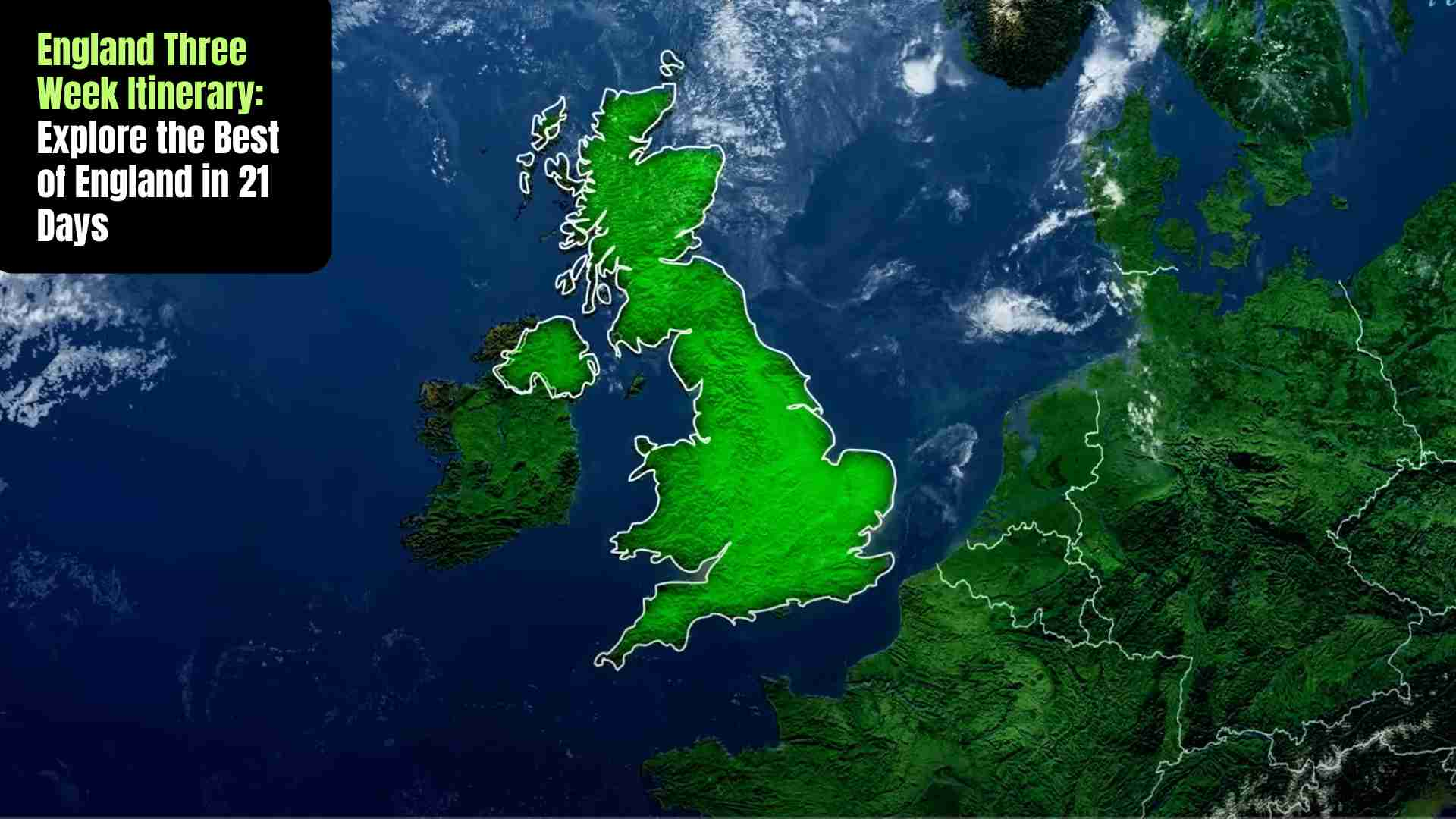Planning a three-week trip to England? You’re in for an incredible journey filled with castles, coastal walks, vibrant cities, and cozy countryside pubs. England may be small on the map, but it’s packed with layers of history, culture, and natural beauty. Whether you’re a first-time visitor or returning for a deeper experience, this England three week itinerary gives you a bit of everything—from London buzz to Lake District calm.
I recently spent three weeks traveling across England, and I’m here to share the exact route I took, what I’d change, and what I’d do again in a heartbeat. Let’s break it down week by week, with tips and insights along the way.
Week 1: London, Windsor & Oxford — Kickstart in the South
Days 1–5: London
Start your adventure in London. It’s big, bold, and bursting with iconic landmarks.
Must-see sights:
- Big Ben and Westminster Abbey
- Buckingham Palace (arrive early to catch the Changing of the Guard)
- British Museum and Tate Modern
- Tower of London and Tower Bridge
- Covent Garden, Soho, and Camden Market
But don’t just rush from one place to the next. One of the best parts of London is soaking it in—strolling along the Thames, having a lazy afternoon in Hyde Park, or sipping a flat white in Shoreditch.
Local tip:
Buy an Oyster Card or use a contactless card to hop on the Tube or buses. It’s cheaper and way easier than paper tickets.
Day 6: Day Trip to Windsor
Just 45 minutes by train from London, Windsor is a charming town best known for Windsor Castle—the Queen’s weekend home. Touring the State Apartments feels like walking through a history book. The castle grounds, St. George’s Chapel, and nearby Long Walk make it a full and lovely day out.
Bonus: Walk across the bridge into Eton for a peek at one of the world’s most prestigious schools.
Day 7: Oxford
Next, take the train or drive to Oxford—home of dreaming spires and scholarly vibes. You only need a day or two here, but it’s packed with charm. Visit the Bodleian Library, climb the tower of the University Church of St. Mary for sweeping views, and take a punting ride on the River Cherwell.

Where to eat: The Turf Tavern (great pub with a hidden alley entrance) or grab lunch at the Covered Market.
Week 2: Cotswolds, Bath & Cornwall — Countryside and Coastline
After a bustling first week, it’s time to slow things down. Week two takes you through the charming English countryside and ends with dramatic coastal views.
Days 8–9: The Cotswolds
You’ve probably seen photos of the Cotswolds without knowing it—think stone cottages, flower-filled gardens, and rolling green hills.
Top villages to visit:
- Bibury – Possibly the prettiest village in England. Arlington Row is postcard-perfect.
- Bourton-on-the-Water – A small river runs through the town, lined with low stone bridges.
- Stow-on-the-Wold – Ideal for antique lovers and cozy tea rooms.
Renting a car here is your best bet. Public transport exists, but connections between the villages can be slow and infrequent.
Travel tip:
Book accommodation in advance. Popular villages get busy, especially on weekends.
Days 10–11: Bath
From the Cotswolds, head to Bath, a city famous for its Roman baths and Georgian elegance.
Don’t miss:
- The Roman Baths and Bath Abbey
- Pulteney Bridge and the Royal Crescent
- The Jane Austen Centre if you’re a fan of classic lit
Bath is also great for relaxing. Treat yourself to a soak at Thermae Bath Spa, where you can enjoy a rooftop thermal pool with views of the city.
Dining tip:
Try Sally Lunn’s for a historic meal (and their legendary buns) or head to The Scallop Shell for some of the best fish and chips in the region.
Days 12–14: Cornwall
End your second week in Cornwall, a rugged and beautiful coastal region in southwest England. It’s a bit of a drive (around 3–4 hours from Bath), but the change in scenery is worth it.
Best spots in Cornwall:
- St Ives – A dreamy town with art galleries, golden beaches, and a laid-back vibe.
- Tintagel Castle – Linked to the legend of King Arthur, with clifftop views that feel otherworldly.
- Minack Theatre – An open-air theatre carved into the cliffs above the Atlantic. Even if you don’t see a show, the setting is magical.
Optional detour: Stop by Port Isaac, filming location for the series Doc Martin.
Note: Public transport in Cornwall exists, but having a car gives you the freedom to explore small coastal villages and hidden beaches.
Week 3: Northern England & the Lake District — Nature, History, and Hidden Gems
The final week of your journey takes you north—where history meets hills, and peaceful lakes contrast with medieval towns.
Days 15–16: York
After Cornwall, it’s a long journey up to York, so plan a full travel day or break the trip with a night in the Midlands (maybe in Birmingham or Stratford-upon-Avon if you’re a Shakespeare fan).
Once you arrive in York, you’ll feel like you’ve stepped back in time.
Must-see in York:
- York Minster – One of Europe’s most beautiful cathedrals. Climb the tower for city views.
- The Shambles – A narrow medieval street that looks like something out of Harry Potter.
- York City Walls – Walk the full circle around the old city for a unique perspective.
York is compact, so it’s easy to explore on foot.
Tip: Try a traditional Yorkshire pudding or have a pint in one of the city’s many old pubs—some claim to be haunted!
Days 17–19: The Lake District
Next, make your way to the Lake District National Park, a region of tranquil lakes, towering fells, and sheep-dotted fields.
Top areas to base yourself:
- Windermere – One of the most popular spots with plenty of walking trails and boat rides.
- Grasmere – Smaller and quieter, and the former home of poet William Wordsworth. Don’t miss Sarah Nelson’s famous gingerbread!
- Keswick – A great hub in the northern part of the park, near Derwentwater and Skiddaw.
Things to do:
- Hike to Orrest Head for panoramic views with minimal effort.
- Rent a boat or take a cruise across Lake Windermere.
- Visit Hill Top, Beatrix Potter’s house.
Even if you’re not a hardcore hiker, the Lake District is a joy. It’s one of those places where simply being there feels good.
Day 20: Liverpool or Manchester
Before heading back south, stop in either Liverpool or Manchester, depending on your interests.
Liverpool is great for Beatles fans, maritime history, and a lively waterfront.
Manchester is more modern, with amazing food, music, and industrial heritage.
Either city makes a great one-day stopover. If you’re flying out of Manchester, it’s convenient to end here.
Day 21: Return to London
Wrap up your journey by returning to London—either by train or a quick domestic flight depending on where you end up. If your flight’s the next day, treat yourself to a nice final dinner or one last walk along the South Bank.
Packing, Budget & Transport Tips for Your England Three Week Itinerary
Planning a long trip is exciting—but it’s easy to overpack or underestimate travel costs. Here’s what I learned from experience to help you stay comfortable, organized, and on budget throughout your England three week itinerary.
What to Pack (and What to Skip)
England’s weather is famously unpredictable. You might get sunshine, drizzle, and wind—all in one day.
Must-pack items:
- A waterproof jacket (light but reliable)
- Comfortable walking shoes (many streets are cobbled)
- Layers: think sweaters, T-shirts, and a scarf
- A small umbrella
- A universal power adapter (UK plugs are different)
- Reusable water bottle (tap water is safe and free in most places)
Skip:
- Heavy coats unless you’re going in winter
- Hair dryers or full-size toiletries (most stays provide these or stores like Boots are everywhere)
- Dressy clothes—England is casual almost everywhere
Getting Around: Trains, Cars & Public Transit
Trains are a great way to travel between major cities like London, Oxford, York, and Manchester. Book in advance on the National Rail website or apps like Trainline to save money.
Pros of train travel:
- Scenic views
- Comfortable and fast
- No parking hassles
Cons:
- Can get pricey last-minute
- Not great for small towns or villages
Car rental is ideal for areas like the Cotswolds, Cornwall, and the Lake District.
Driving tips:
- Drive on the left side of the road
- Many roads are narrow and winding, especially in the countryside
- Use apps like Waze or Google Maps, but always double-check for tolls and parking
City transport:
In London and other big cities, use public transit. Buses and the underground are efficient and cheaper than taxis.
Budget Tips: What a 3-Week Trip Might Cost
Let’s break it down with average daily costs per person (in GBP):
| Category | Budget (£) | Mid-range (£) | Luxury (£) |
| Accommodation | £30–£60 | £80–£150 | £200+ |
| Meals | £15–£25 | £30–£50 | £70+ |
| Transport | £10–£20 | £25–£40 | £60+ |
| Activities/Entry | £5–£15 | £20–£30 | £40+ |
Total average per day (mid-range): £130–£180
Money-saving ideas:
- Book train tickets early (often much cheaper than same-day fares)
- Travel off-peak (May–June or September)
- Look for combo tickets (like London Pass or National Trust memberships)
- Eat at pubs—they often have hearty, affordable meals
Final Thoughts: Is a Three Week England Itinerary Worth It?
If you’re wondering whether three weeks in England is too long or just right—the short answer is: it’s perfect.
England may not cover a huge landmass, but it’s full of variety. In just 21 days, you can experience the buzz of London, the gentle charm of the Cotswolds, the Roman history in Bath, the salty air of Cornwall, the medieval magic of York, and the peaceful hills of the Lake District. Every region feels like a new chapter.
Pros of a Three Week England Itinerary
- You can travel slow. You’re not rushing from one place to the next every day. This leaves room for spontaneous stops and detours.
- You see real contrasts. From the modern skyline of London to the rustic charm of northern villages.
- Better value. Spreading fixed costs like airfare over three weeks gives you more value per travel day.
- Less burnout. With time to rest, you’re more likely to actually enjoy what you’re seeing instead of powering through.
A Few Downsides to Watch Out For
- Weather mood swings. Pack flexible clothes—it really can rain and shine within an hour.
- Driving stress. If you’re not used to narrow roads and driving on the left, the countryside can be tricky.
- Train costs. UK train tickets can be shockingly high without advance bookings.
- Tourist crowds. In summer, places like Bath and the Lake District can feel overrun. Book stays early or go shoulder season.
Tips for First-Time Visitors
- Start with a plan, but stay flexible. Some of your best moments may be unplanned.
- Don’t skip the small towns. Big cities are exciting, but the soul of England often lies in its tiny pubs and village lanes.
- Talk to locals. Whether it’s a B&B host or a barista, chatting with people often leads to local secrets.
- Embrace the rain. A misty walk through a quiet meadow or an afternoon spent in a cozy pub can be just as magical as a sunny day at the beach.
- Balance busy days with quiet ones. After London or York, give yourself a breather in the Lakes or the Cotswolds.
Your England Adventure Awaits
This England three week itinerary isn’t about ticking off every tourist site. It’s about feeling England—from the crunch of gravel on a country path to the roar of a football crowd, from historic cities to seagull-filled harbors.
Whatever your pace or interest, you’ll find something to love here. And with a thoughtful route, practical tips, and a little curiosity, your 21-day England adventure can be something you remember for a lifetime.


